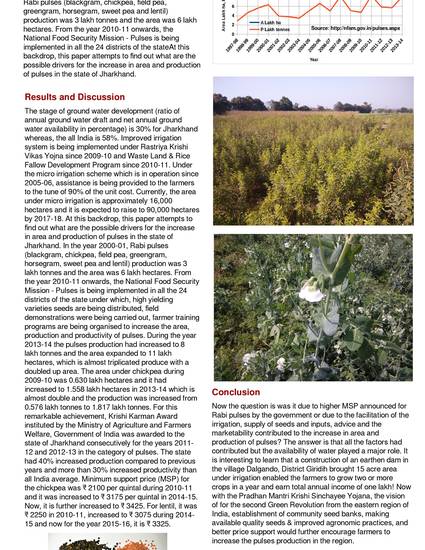
Presentation
Rice Fallow Divergence: Catalysing the Pulses Revolution in Jharkhand?
Conference: Pulses for Sustainable Agriculture and Human Health Organized by International Food Policy Research Institute (IFPRI), National Academy of Agricultural Sciences (NAAS), TCi of Cornell University (TCi-CU) and Indian Council of Food and Agriculture (ICFA)
(2016)
Abstract
The state of Jharkhand came into existence by bifurcating the Bihar state in the year 2000. It is the forest hub and is rich in mineral resources contributing to tune of 40% of the India’s mineral resources. However, as per UNDP, out of 33 million population, 12.62 million are poor and 57% of the children who are less than five years are under malnutrition. Though 80% of the population are involved in farming, only 32% of the area is under net sown out of which only 12% is irrigated. The per capita availability of food grains is 546g but then the accessibility of the same is in question as 39% of the population live under below poverty line earning $ 1 a day (as purchasing power parity). Due to various socioeconomic constraints, only 1/4th of the net sown area is utilized in Rabi and most of the lands are left as fallow. The stage of ground water development (ratio of annual ground water draft and net annual ground water availability in percentage) is 30% for Jharkhand whereas, the all India is 58%. Improved irrigation system is being implemented under Rastriya Krishi Vikas Yojna since 2009-10 and Waste Land & Rice Fallow Development Program since 2010-11. Under the micro irrigation scheme which is in operation since 2005-06, assistance is being provided to the farmers to the tune of 90% of the unit cost. Currently, the area under micro irrigation is approximately 16,000 hectares and it is expected to raise to 90,000 hectares by 2017-18. At this backdrop, this paper attempts to find out what are the possible drivers for the increase in area and production of pulses in the state of Jharkhand. In the year 2000-01, Rabi pulses (blackgram, chickpea, field pea, greengram, horsegram, sweet pea and lentil) production was 3 lakh tonnes and the area was 6 lakh hectares. From the year 2010-11 onwards, the National Food Security Mission - Pulses is being implemented in all the 24 districts of the state under which, high yielding varieties seeds are being distributed, field demonstrations were being carried out, farmer training programs are being organised to increase the area, production and productivity of pulses. During the year 2013-14 the pulses production had increased to 8 lakh tonnes and the area expanded to 11 lakh hectares, which is almost triplicated produce with a doubled up area. The area under chickpea during 2009-10 was 0.630 lakh hectares and it had increased to 1.558 lakh hectares in 2013-14 which is almost double and the production was increased from 0.576 lakh tonnes to 1.817 lakh tonnes. For this remarkable achievement, Krishi Karman Award instituted by the Ministry of Agriculture and Farmers Welfare, Government of India was awarded to the state of Jharkhand consecutively for the years 2011-12 and 2012-13 in the category of pulses. The state had 40% increased production compared to previous years and more than 30% increased productivity than all India average. Minimum support price (MSP) for the chickpea was ₹ 2100 per quintal during 2010-11 and it was increased to ₹ 3175 per quintal in 2014-15. Now, it is further increased to ₹ 3425. For lentil, it was ₹ 2250 in 2010-11, increased to ₹ 3075 during 2014-15 and now for the year 2015-16, it is ₹ 3325. Now the question is was it due to higher MSP announced for Rabi pulses by the government or due to the facilitation of the irrigation, supply of seeds and inputs, advice and the marketability contributed to the increase in area and production of pulses? The answer is that all the factors had contributed but the availability of water played a major role. It is interesting to learn that a construction of an earthen dam in the village Dalgando, District Giridih brought 15 acre area under irrigation enabled the farmers to grow two or more crops in a year and earn total annual income of one lakh! Now with the Pradhan Mantri Krishi Sinchayee Yojana, the vision of for the second Green Revolution from the eastern region of India, establishment of community seed banks, making available quality seeds & improved agronomic practices, and better price support would further encourage farmers to increase the pulses production in the region.
Keywords
- Rice Fallows,
- Pulses,
- Jharkhand
Disciplines
Publication Date
May 31, 2016
Location
New Delhi. NASC Complex, Pusa New Delhi India.
DOI
10.7490/f1000research.1112177.1
Citation Information
Sridhar Gutam. "Rice Fallow Divergence: Catalysing the Pulses Revolution in Jharkhand?" Conference: Pulses for Sustainable Agriculture and Human Health Organized by International Food Policy Research Institute (IFPRI), National Academy of Agricultural Sciences (NAAS), TCi of Cornell University (TCi-CU) and Indian Council of Food and Agriculture (ICFA) (2016) Available at: http://works.bepress.com/sridhar_gutam/55/
